Nov 6, 2009
Olympus PEN E-P2 Preview

And here it is, our preview of Olympus’ latest Micro Four Thirds camera, the PEN E-P2! The Olympus E-P2 is an evolutionary upgrade and is pretty similar to the E-P1 PEN announced in July, but sports several tweaks. Hit the link for all the juicy details about the camera, and also remember to head on to the Olympus E-P2 PEN photo gallery for image samples.
*Note from Brad: A big thank you to the folks at Olympus who made previewing of the PEN E-P2 on DPInterface possible. And another special thanks to them for giving the green light to make our preview gallery available to readers.
DPInterface Olympus PEN E-P2 Preview
Brad Soo – November 6th, 2009
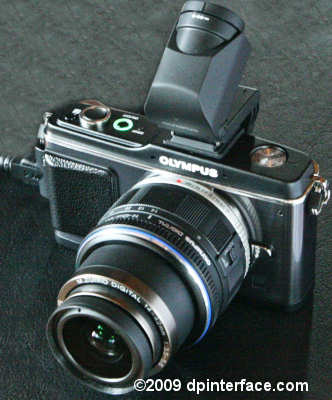
A little over four months ago, Olympus released their first ever Micro Four Thirds, the E-P1 PEN. The E-P1’s features were perhaps not game-changing but its compact, rectangular form-factor (ala Olympus’ E300/E330) made it a mouth-watering choice for those wanting a light, discrete interchangeable lens camera. Despite some of the E-P1’s shortcomings, many photographers (existing digital SLR owners) embraced it as a secondary camera for street-shooting, a travel camera and/or as a backup unit.
Olympus wants to make things better, and give prospective buyers a choice, with their new PEN E-P2. The Olympus E-P2 is an evolutionary upgrade to the E-P1, featuring several minor improvements and new features, and I’ve gotten official word that it will NOT replace the E-P1, at the moment. Instead, the Olympus PEN E-P1 and PEN E-P2 cameras will sell alongside each other, the latter being more suitable for people wanting more “expandability”
Before we move on, here’s what the Olympus E-P2 has in store for you:
- 12 effective megapixels
- Micro Four Thirds lens mount (Also takes full-size Four Thirds and some Leica lenses via their respective adapters)
- 3 inch LCD (230,000 pixels) for live view
- 3 frames per second burst mode
- ISO range of 100 - 6400
- 8 Art Filters; two new Art Filters
- Full manual controls
- New accessory port for external EVF and dedicated stereo microphone
- 720p HD movie mode, records at 30 FPS with sound
- Point-and-shoot modes for beginners, including Intelligent Auto mode
- HDMI output port

And here’s my usual disclaimer for camera previews: the Olympus PEN E-P2 unit previewed here is a pre-production model. That means things here are subject to change and you should NOT judge the Olympus PEN E-P2 until our final review comes out. All product shots and gallery sample photos once I get my hands on a 100% finalized, retail version of the Olympus PEN E-P2 in the future.
With that out of the way, let’s find out more about the evolutionary PEN E-P2 camera!
Changes: PEN E-P1 vs PEN E-P2
The difference between the PEN-twins isn’t large, so I’ve managed to list the changes here:
- Black body color
- New: Accessory port for add-ons (currently an external EVF and microphone)
- New: External electronic viewfinder; very high in resolution, very big and comes bundled with the camera
- New: Autofocus tracking mode
- New: iEnhance feature; makes main color in a photo brighter and more vivid
- Two new Art Filters (Diorama and Cross process)
- Playback browsing control over HDMI
Size and Weight
(288.2) 128.8 x 97.5 x 61.9 mm (480 g) – Canon Digital Rebel T1i aka EOS 500D*
(311.0) 127.0 x 104.0 x 80.0 mm (560 g) – Nikon D5000*
(284.0) 130.0 x 94.0 x 60.0 mm (475 g) – Olympus E620
(226.9) 120.6 x 69.9 x 36.4 mm (335 g) – Olympus E-P1*
(226.9) 120.5 x 70.0 x 36.4 mm (335 g) – Olympus E-P2*
(258.8) 124.0 x 89.6 x 45.2 mm (385 g) – Panasonic Lumix G1/GH1*
(226.3) 119.0 x 71.0 x 36.3 mm (285 g) – Panasonic Lumix GF1*
(281.0) 122.5 x 91.0 x 67.5 mm (515 g) – Pentax K-x
(296.7) 128.0 x 97.0 x 71.7 mm (490 g) – Sony Alpha A380
*Features movie mode (Video recording with sound)
All the weight figures above show when the camera is empty without any lens, battery or memory card
The Olympus PEN E-P2 isn’t exactly the camera that you would want to stuff into your pants pocket, but it’s pretty darn small for an interchangeable lens camera (a whole lot smaller than your average digital SLR, that’s for sure!). The dimensions have shifted ever so slightly but the camera remains the same size as the original E-P1 digital PEN. There are not many protrusions on the camera; those that are present do not stick out as far as on their digital SLR counterparts (ie hotshoe mount, front ‘grip’), which makes the E-P2 a lot more portable. The only camera that’s smaller than the E-P1/E-P2 twins is their not-so-distant cousin, the Panasonic GF1.
Box packaging

The Olympus E-P2 PEN will come with your standard interchangeable lens camera box contents plus a pleasant little surprise – an external electronic viewfinder! (Supposedly that’s already factored into the price of the Olympus E-P2)
- Olympus PEN E-P2 camera body
- External electronic viewfinder (EVF)
- BLS-1 rechargeable lithium-ion battery (with case)
- Battery charger
- Neck strap
- USB and A/V cables
- Camera software CD
- User’s manual
- Olympus Micro Zuiko 14 – 42 mm f3.5 - f5.6 kit lens (with kit lens option)
- Olympus Micro Zuiko 17 mm f2.8 pancake lens (with pancake kit option)
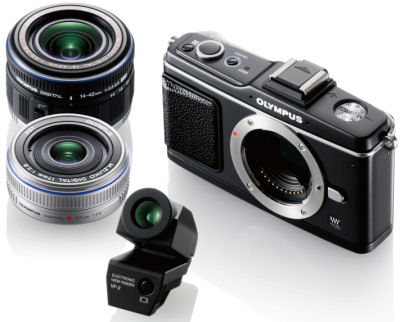
Depending on which kit you ordered, you’ll either get the PEN E-P2 body only, with a standard zoom lens or pancake lens. Olympus says the external electronic viewfinder will come bundled as a standard with the E-P2 (regardless of kit).
The Olympus PEN E-P2 doesn’t include any internal memory or memory card, so you need to use your own. The PEN E-P2 takes SD/SDHC cards (but not Olympus’ own xD-Picture cards, surprisingly) just like the E-P1 before it and a 4 to 8 GB card will be good to start with. The PEN E-P2 is able to perform faster when using a high-speed memory card (90X to 150X speed will do) so consider picking up one with the camera.
500 shots – Canon Digital Rebel T1i aka 500D
190 shots – Canon Digital Rebel T1i aka 500D (LCD live view)
500 shots – Nikon D60
510 shots – Nikon D5000
210 shots – Nikon D5000 (LCD live view)*
500 shots – Olympus E620
200 shots – Olympus E620 (LCD live view)*
300 shots – Olympus PEN E-P1 (LCD live view)
300 shots – Olympus PEN E-P2 (LCD live view)
330 shots – Panasonic Lumix G1 (LCD live view)
300 shots – Panasonic Lumix GH1 (LCD live view)
380 shots – Panasonic Lumix GF1 (LCD live view)
640 shots – Pentax K-x
500 shots – Sony Alpha A380
230 shots – Sony Alpha A380 (LCD live view)
*In-house testing done by DPInterface. Our tests were conducted as close as possible to CIPA’s procedures
All the cameras above are rated with rechargeable batteries according to CIPA Standard; when using the viewfinder, unless noted otherwise
Stacking up the Olympus PEN E-P2’s battery life against other cameras is a challenging task – the camera is a lot smaller than regular digital SLRs, yet the same size or slightly bigger than fixed-lens, prosumer camera models. Also, the PEN E-P2 is a live-view only camera, so while it beats all the digital SLRs in battery life when using live view, there’s no way it can compare to SLRs and their optical viewfinders (which increase battery life significantly).
The Olympus PEN E-P2 has the same battery life rating of 300 shots per charge as its sibling, and as of whole (compared to just ‘cameras’ in general, not referring to any specific class), its battery life is slightly above average and should be able to last for half to a full day of casual shooting (varies by photographer). On a side note, the E-P2’s cousin, the GF1 outlasts it by 30% in the battery life department.
Accessories
The Olympus PEN E-P2 is a Micro Four Thirds camera that natively supports Micro Four Thirds lenses but can also take full-size Four Thirds, Leica and Olympus OM lenses via their respective adapters. The catch if you wanna use those non-native lenses are their pricey adapters and the fact that not all lenses will autofocus with the camera.
Unless you have a couple of other lenses lying around, I would recommend getting only Micro Four Thirds lenses if you’re starting ‘fresh’ to save the hassle. Olympus currently offers the 14-42 mm retractable kit lens and 17 mm f2.8 pancake lens for Micro Four Thirds, though they will be adding their new 9-18 mm ultra-wide angle and 14-150 mm super-zoom lenses into the mix in 2010. Panasonic, a member in the Four Thirds/Micro Four Thirds system, also makes four lenses which are fully compatible with the Olympus E-P2. They cover: 7-14 mm, 14 – 45 mm, 45-200 mm and 14-140 mm.
As the Micro Four Thirds standard is relatively new, expect a variety of new lenses to be introduced in the future. All lenses mounted on the camera will be subjected to the sensor’s 2.0X focal length multiplication factor.
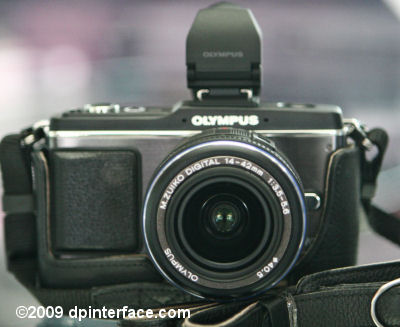
There are also other accessories available for the Olympus E-P2, including a specialized, faux-leather jacket offers protection without hindering access to the camera’s controls and lens. There’s also an optional wired remote control and HDMI cable for the camera.
There are three accessories currently not offered for the Olympus E-P2: an AC adapter, underwater cases and battery/vertical grip. It is unknown if Olympus will be announcing them in the future (I wouldn’t hold my breath though)
Camera Tour
On the outside, the Olympus PEN E-P2 looks a whole lot like its predecessor; with the only changes being the new dark-gray/black body color and addition of an accessory port behind the hotshoe. Other than that, the Olympus E-P2 has the same solid, retro-looking body of its sibling, the E-P1.
Ergonomics are surprisingly good with even weight distribution (with the kit lens), sufficient space to hold the camera and nice, tactile buttons and controls. However, my quirks about the back vertical dial and mode dial still remain – both are slightly too recessed and still awkward to operate.
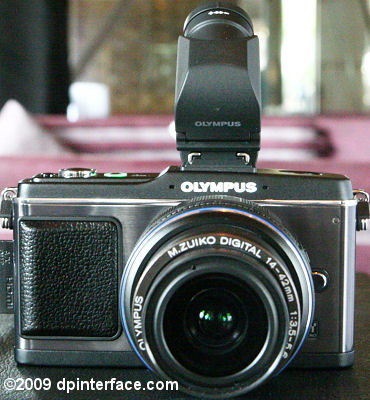
Front of the Olympus PEN E-P2.
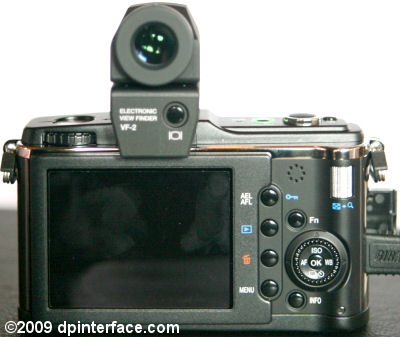
Back of the Olympus PEN E-P2.
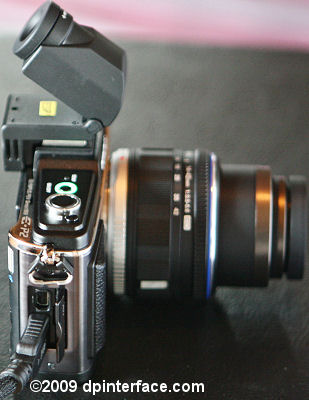
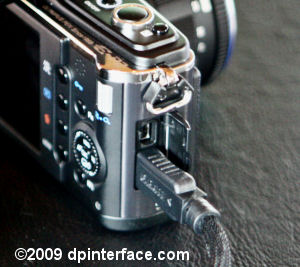
Ports found on the Olympus PEN E-P2.
Video Recording
The Olympus PEN E-P2 has exactly the same HD movie mode as the E-P1. You can record 720p video clips (1280 x 720) with stereo sound at 30 FPS. The only addition on the E-P2 is the ability to attach an external, dedicated microphone to the camera (mounted via the accessory port to the hotshoe) for better sound quality. The camera’s built-in pair of microphones still record sound at 44.1 kHz and movies are saved in M-JPG format.
You can manually operate the camera’s zoom lens, focus (or even toggle on the continuous AF function) and adjust aperture value while recording movies, but you cannot use the E-P2’s sensor-shift image stabilization or take a still picture in the midst of recording. The 2 GB per movie clip file size limitation is also here. Art Filters can be used when recording, but movie frame rates drop significantly when they are used.
Well, that’s enough for now. I’ll talk more about the Olympus PEN E-P2’s movie-taking abilities in the final review of the camera.
Performance
The Olympus E-P2 has a burst mode that can shoot continuously at 3 frames per second, just like its two compact buddies in the Micro Four Thirds system, the PEN E-P1 and Lumix GF1.
In terms of autofocus, the Olympus PEN E-P2 shares the same AF system (hardware and firmware wise) as the PEN E-P1. Autofocus speeds clocked in a hair faster than the PEN E-P1 before its firmware update, and about the same as the PEN E-P1 after the update. The E-P2 also lacks an autofocus assist lamp for low-light situations…
So I’ll save the numbers for the final review, but I can only hope that Olympus comes up with something to improve autofocus performance by the time the final, mass-production PEN E-P2’s arrive next month (or January 2010 for some countries).
PEN E-P2 sample crops
DISCLAIMER: Photos here were taken using a pre-production unit of the Olympus PEN E-P2. The sample photos here are merely ‘teasers’ of what to expect from the camera, though image quality is subject to change on the finalized version of the camera. Please wait until our final review to judge image quality.








PEN E-P2 photo gallery
Check out other full-sized photos taken straight from the camera in the Olympus PEN E-P2 preview gallery.
Final thoughts
The Olympus PEN E-P2 is like a souped-up version of the E-P1 released five months ago. The Olympus E-P2 features several small changes (which are mostly firmware stuff), a repainted black body and a new accessory port – which is probably the most significant change on the camera. The accessory port allows you to connect an external electronic viewfinder (EVF) or dedicated microphone to the camera, with more potential add-ons in the future. The external EVF (which comes bundled with the camera) solves the complain people had with the E-P1 – the lack of a viewfinder for steadying the camera to your eye.
With the announcement of the new PEN E-P2, Olympus is giving prospective buyers a choice – to save some cash with the similar PEN E-P1 model or to go with the more expandable PEN E-P2, which also happens to have several minor new features. Well, having a choice is better than having none… and we’ll have a more in-depth discussion and overview of the Olympus PEN E-P2, and a conclusion, once we get a final, production-level unit of the camera for review.
If you have any questions, feel free to leave them in the comments section below and I’ll try my best to answer them.

















I’ve only just discovered your website and appreciate both your reviews as well as your style of writing. I’ll be looking forward to your final E-P2 review. As a former OM-1 photographer, who has been out of the digital photography world except for some pretty basic point and shoots, I’ve been intrigued by this new Olympus.